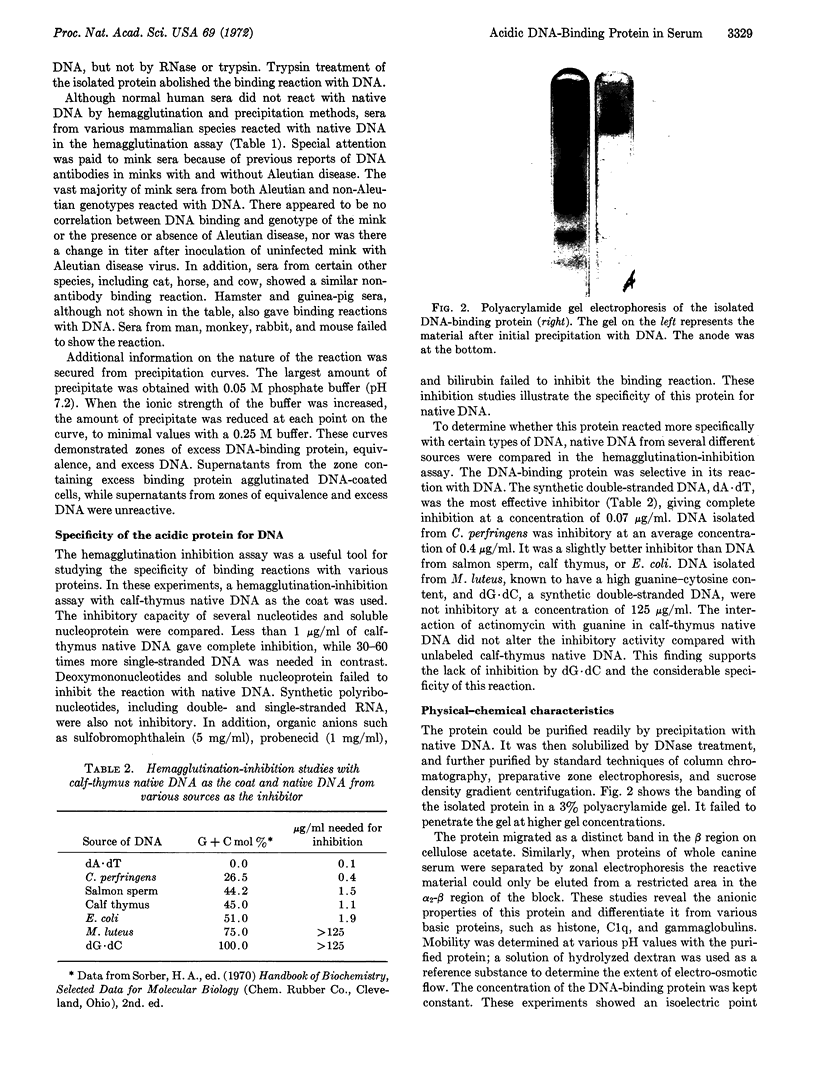Abstract
Various mammalian species contain an anionic serum protein that reacts specifically with native DNA. It is considerably less reactive with single-strand DNA and does not react with monodeoxyribonucleotides, homopolyribonucleotides, or duplexes of homopolyribonucleotides. Synthetic dA·dT was an effective inhibitor of the reaction with native DNA, while Micrococcus luteus DNA and dG·dC were not inhibitory.
This protein was encountered in the course of studies on DNA antibodies. Although it reacted with red cells coated with DNA and gave agar precipitation bands, it was clearly distinct from DNA antibodies. It was found in the serum of all animals of a given species, migrated as an α-β globulin, and did not crossreact with gammaglobulins. It reacted with DNA in solution to give precipitation curves that were strongly influenced by changes in ionic strength. The protein was isolated from canine serum by precipitation with DNA and purified to homogeneity, as judged by immunochemical and electrophoretic criteria.
A similar protein was found in mink, equine, and other sera, but not in human sera. Previous studies on DNA antibodies in certain experimental animals may have given false positive results due to this protein.
Keywords: Dog, mink, acidic serum protein, protein purification
Full text
PDF



Images in this article
Selected References
These references are in PubMed. This may not be the complete list of references from this article.
- Agnello V., Winchester R. J., Kunkel H. G. Precipitin reactions of the C1q component of complement with aggregated gamma-globulin and immune complexes in gel diffusion. Immunology. 1970 Dec;19(6):909–919. [PMC free article] [PubMed] [Google Scholar]
- Alberts B. M. Function of gene 32-protein, a new protein essential for the genetic recombination and replication of T4 bacteriophage DNA. Fed Proc. 1970 May-Jun;29(3):1154–1163. [PubMed] [Google Scholar]
- Barnett E. V., Williams R. C., Jr, Kenyon A. J., Henson J. E. 'Nuclear' antigens and antinuclear antibodies in mink sera. Immunology. 1969 Feb;16(2):241–253. [PMC free article] [PubMed] [Google Scholar]
- DAVIS B. J. DISC ELECTROPHORESIS. II. METHOD AND APPLICATION TO HUMAN SERUM PROTEINS. Ann N Y Acad Sci. 1964 Dec 28;121:404–427. doi: 10.1111/j.1749-6632.1964.tb14213.x. [DOI] [PubMed] [Google Scholar]
- Englund P. T., Kelly R. B., Kornberg A. Enzymatic synthesis of deoxyribonucleic acid. XXXI. Binding of deoxyribonucleic acid to deoxyribonucleic acid polymerase. J Biol Chem. 1969 Jun 10;244(11):3045–3052. [PubMed] [Google Scholar]
- Hillyer G. V. Deoxyribonucleic acid (DNA) and antibodies to DNA in the serum of hamsters and man infected with schistosomes. Proc Soc Exp Biol Med. 1971 Mar;136(3):880–883. doi: 10.3181/00379727-136-35386. [DOI] [PubMed] [Google Scholar]
- KUNKEL H. G., TISELIUS A. Electrophoresis of proteins on filter paper. J Gen Physiol. 1951 Sep;35(1):89–118. doi: 10.1085/jgp.35.1.89. [DOI] [PMC free article] [PubMed] [Google Scholar]
- Kleinsmith L. J., Allfrey V. G. Nuclear phosphoproteins. I. Isolation and characterization of a phosphoprotein fraction from calf thymus nuclei. Biochim Biophys Acta. 1969 Feb 4;175(1):123–135. [PubMed] [Google Scholar]
- Koffler D., Carr R. I., Agnello V., Fiezi T., Kunkel H. G. Antibodies to polynucleotides: distribution in human serums. Science. 1969 Dec 26;166(3913):1648–1649. doi: 10.1126/science.166.3913.1648. [DOI] [PubMed] [Google Scholar]
- Koffler D., Carr R., Agnello V., Thoburn R., Kunkel H. G. Antibodies to polynucleotides in human sera: antigenic specificity and relation to disease. J Exp Med. 1971 Jul 1;134(1):294–312. doi: 10.1084/jem.134.1.294. [DOI] [PMC free article] [PubMed] [Google Scholar]
- Lambert P. H., Dixon F. J. Pathogenesis of the glomerulonephritis of NZB/W mice. J Exp Med. 1968 Mar 1;127(3):507–522. doi: 10.1084/jem.127.3.507. [DOI] [PMC free article] [PubMed] [Google Scholar]
- LeStourgeon W. M., Rusch H. P. Nuclear acidic protein changes during differentiation in Physarum polycephalum. Science. 1971 Dec 17;174(4015):1233–1236. doi: 10.1126/science.174.4015.1233. [DOI] [PubMed] [Google Scholar]
- Plescia O. J., Braun W. Nucleic acids as antigens. Adv Immunol. 1967;6:231–252. doi: 10.1016/s0065-2776(08)60523-4. [DOI] [PubMed] [Google Scholar]
- ROBBINS W. C., HOLMAN H. R., DEICHER H., KUNKEL H. G. Complement fixation with cell nuclei and DNA in lupus erythematosus. Proc Soc Exp Biol Med. 1957 Dec;96(3):575–579. doi: 10.3181/00379727-96-23545. [DOI] [PubMed] [Google Scholar]
- SELIGMANN M., MILGROM F. Mise en évidence par la fixation du complément de la réaction entre acide désoxyribonucléique et sérum de malades atteints de lupus érythémateux disséminé. C R Hebd Seances Acad Sci. 1957 Oct 21;245(17):1472–1475. [PubMed] [Google Scholar]
- Salas J., Green H. Proteins binding to DNA and their relation to growth in cultured mammalian cells. Nat New Biol. 1971 Feb 10;229(6):165–169. doi: 10.1038/newbio229165a0. [DOI] [PubMed] [Google Scholar]
- Steinberg A. D., Pincus T., Talal N. DNA-binding assay for detection of anti-DNA antibodies in NZB-NZW F1 mice. J Immunol. 1969 Mar;102(3):788–790. [PubMed] [Google Scholar]
- Tan E. M., Schur P. H., Carr R. I., Kunkel H. G. Deoxybonucleic acid (DNA) and antibodies to DNA in the serum of patients with systemic lupus erythematosus. J Clin Invest. 1966 Nov;45(11):1732–1740. doi: 10.1172/JCI105479. [DOI] [PMC free article] [PubMed] [Google Scholar]
- Teng C. T., Teng C. S., Allfrey V. G. Species-specific interactions between nuclear phosphoproteins and DNA. Biochem Biophys Res Commun. 1970 Nov 9;41(3):690–696. doi: 10.1016/0006-291x(70)90068-9. [DOI] [PubMed] [Google Scholar]
- Thoburn R., Koffler D., Kunkel H. G. Distribution of antibodies to native DNA, single-stranded DNA, and double-stranded RNA in mouse serums. Proc Soc Exp Biol Med. 1971 Mar;136(3):711–714. doi: 10.3181/00379727-136-35347. [DOI] [PubMed] [Google Scholar]




